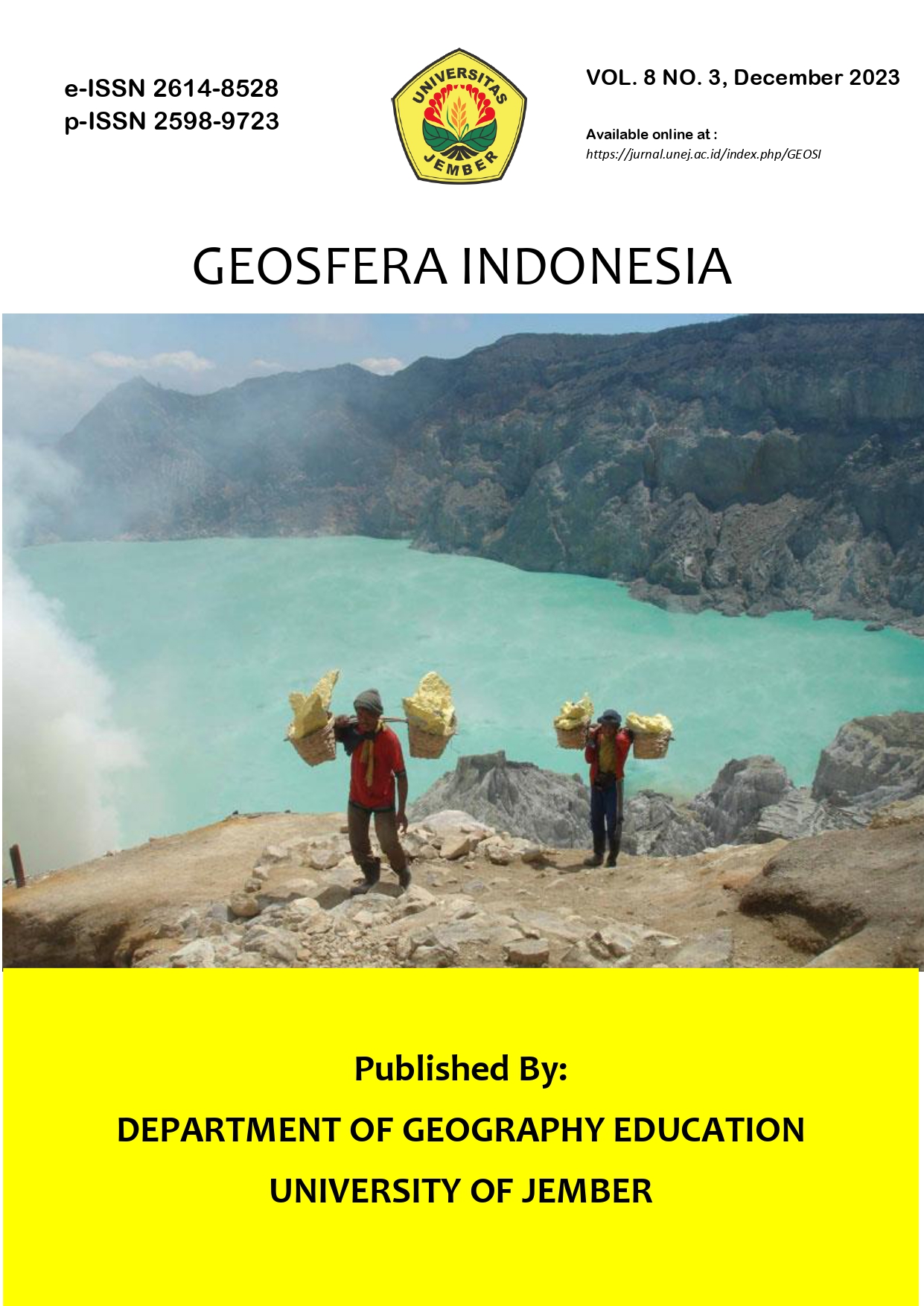Geo-Quantitative Analysis of Violent Crime Intervention Strategies in Kaduna State, Nigeria
DOI:
https://doi.org/10.19184/geosi.v8i3.42372Keywords:
Violence, crime, intervention, mediation, government policyAbstract
The complexities and consequences of violent crimes require a robust and effective approach to achieve a sustainable reduction of violence in our society. This paper, therefore, presents an avenue to provide the geo-quantitative analysis of violent occurrences in Kaduna State of Nigeria to determine the pragmatic interventionist strategies for managing violent crime incidence among the people of the study area. Geo-quantitative analysis entails transforming numerical data about criminal activities into a map of proportional circles to depict the distribution pattern of criminal activities and using scree plots and factor loading to show higher-order intervention measures for managing violent crimes. Five Local Government Areas (LGAs) with relatively high levels of violent incidence were purposively selected while snowball sampling method was used to administer questionnaires to 384 respondents. From the findings, the spatial distribution of violent crimes revealed that Birni-Gwari and Kachia LGAs accounted for the highest incidence of kidnapping and village raids respectively while Kajuru LGA is known for the highest cases of cattle rustling and armed robbery. The critical interventions in managing violent crimes are reconciliation efforts to restore order and normalcy, negotiation between aggrieved parties, and adoption of a traditional conflict resolution system with a rotated factor matrix of 0.828, 0.581, and 0.544 respectively. Furthermore, the strongest positive correlation exists between good government policies and equity with fairness in representation and establishment of developmental projects (r = 0.524, and p Ë‚ 0.001). Therefore, the study recommended establishing conflict mediation centers across the communities. Similarly, it is essential to have a good governance system that will give people their fair share of national resources and adequate policing of communities that could guarantee the reduction of violent incidents to the barest minimum.
Downloads
References
Amali, S., Ilim, M. M., & Lawal, O. Y. (2019). A Survey of the proliferation of small arms and cattle rustling in birnin gwari local government area of kaduna state and its implication to national security. International Journal of Research and Innovation in Social Science (IJRISS), 3(3), 2454–6186.
Babagana, M., Ismail, M., Mohammed, B. G., Dilala, M. A., I, H., & Zangoma, I. M. (2018). Impacts of Boko Haram Insurgency on Agricultural Activities in Gujba Local Government Area, Yobe State, Nigeria. International Journal of Contemporary Research and Review, 9(12), 20268–20282. https://doi.org/10.15520/IJCRR.V9I12.631.
Buckly-Zistel, S. (2008). Violent Conflicts and their Termination. In Buckly-Zistel Susanne (Ed.), Conflict Transformation and Social Change in Uganda: Remembering After Violence. (pp. 12–29). Macmillan, Basingstoke.
Ibrahim, B., & Mukhtar, J. I. (2017). An Analysis of the causes and consequences of kidnapping in Nigeria. African Research Review, 11(4), 134. https://doi.org/10.4314/afrrev.v11i4.11.
Ibrahim, J. (2019). The Trajectory of Mass Killings, Atrocities and Scorched Earth in Nigeria, By Jibrin Ibrahim- Premium Times Opinion. Premium Times Newspaper. Retrieved from https://opinion.premiumtimesng.com/2019/04/12/the-trajectory-of-mass-killings-atrocities-and-scorched-earth-in-nigeria-by-jibrin-ibrahim/?tztc=1.
Iliyasu, D., Lawan, A., Ibrahim, Y., Omonike, O. S., & Muktar, A. (2015). The repercussion of Insurgence Activities of Boko Haram on Management of Livestock and Production in Northeastern Part of Nigeria. Journal of Animal Production Advances, 5(3), 624–628.
Kaduna State Government. (2016). Kaduna State Development Plan 2016-2020: Delivering on Jobs, Social Justice and Prosperity. Kaduna State Ministry of Budget and Planning, Kaduna.
Kaduna State Government. (2017). Kaduna State Infrastructure Master Plan 2018-2020: Providing the Infrastructure to Accelerate Our Development. Kaduna State Ministry of Works, Housing and Transportation, Kaduna State Press, Kaduna. Retrieved from www.mobp.kadgov.ng.
Laudau, S., & Everitt, B. S. (2003). A Handbook of Statistical Analyses Using SPSS (S. E. B. S. Landau, Ed.; 1st ed., Vol. 1). Chapman and Hall/CRC. https://doi.org/10.1201/9780203009765
Mamman, M., Laah, J. G., Ubogu A. E., & Bonat, Z. K. A. (2014). Urban and Rural Youth Violence: Exploration of Sustainable Management of Youth Violence in Kaduna. In O. I. Edwin & I. J. Musa (Eds.), International Conference on Disaster Management tagged ‘Reducing Risk and Building Disaster Resilience. (pp. 113–130). Centre for Disaster Risk Management and Development Studies, Ahmadu Bello University, Zaria.
Murtala, A. R. (2018). Cattle rustling and armed banditry along Nigeria-Niger Borderlands. IOSR Journal of Humanities and Social Science, 23(4), 66–73. https://doi.org/10.9790/0837-2304046673
Nadama, M. U. (2019). Armed Banditry and Internal Security in Zamfara State. International Journal of Scientific and Engineering Research, 10(8), 1219–1226.
Ojo, J. S. (2020). Governing “Ungoverned Spaces†in the Foliage of Conspiracy: Toward (Re)ordering Terrorism, from Boko Haram Insurgency, Fulani Militancy to Banditry in Northern Nigeria. African Security, 13(1), 77–110. https://doi.org/10.1080/19392206.2020.1731109
Onwuaroh, A. S., Yusuf, R. O., & Akpu, B. (2017). Impact of insurgency on income of farmers in Northeastern Nigeria. Dutse Journal of Pure and Applied Sciences (DUJOPAS), 3(2).
Rubin, J., Gallo, F., & Coutts, A. (2008). Violent crime: Risk models, effective interventions and risk management. Retrieved from www.rand.org.
Shittu, H. B., Adekola, N. O., Zamani, A., Aminu, B., Ishaku, A. Y., & Adama, A. M. (2022). Megacity crime management strategies on human security: Evidence of target hardening and developmental prevention in Lagos state, Nigeria. World Journal of Advanced Research and Reviews, 16(1), 717–726. https://doi.org/10.30574/WJARR.2022.16.1.1070
Tahir, A. T., & Usman, O. B. (2021). Curbing Armed Banditry in Nigeria: A Panacea for Good Governance. Zamfara Journal of Politics and Development, 2(2), 1–11. https://zjpd.com.ng/index.php/zjpd/article/view/56
Ubogu, A. E. (2013). Determinants of passengers’ choice: a case study of Mallam Aminu Kano International Airport (Nigeria). International Journal for Traffic and Transport Engineering, 3(3), 230–242. https://doi.org/10.7708/IJTTE.2013.3(3).01.
Ubogu, A. E., Yahaya, O. Y., Adamu, G. K., & Ibrahim, A. (2023). Causal factors of violent incidence in Kaduna State, Nigeria. Bokkos Journal of Applied Scientific Reports, 2(1), 33–45. https://doi.org/10.47452/bjasrep.v2i1.58.
United States Department of Justice. (2021). Comprehensive Strategy for Reducing Violent Crimes, Memorandum for Department of Justice Employees. Retrieved from https://www.justice.gov/dag/page/file/1397921/download
UNODC. (2019). Promoting education to prevent crime, drug use, and violent extremism in Nigeria. United Nations Office on Drugs and Crime. Retrieved from https://www.unodc.org/nigeria/en/press/promoting-education-to-prevent-crime--drug-use--and-violent-extremism-in-nigeria.html.
Uthman, S. (2017). Effect of Conflict on Food Security: A Case Study of Nigeria And Sudan - My School Trick. Business/Public Project Materials, Abuja, Nigeria. Retrieved from https://myschooltrick.com/effect-of-conflict-on-food-security/




